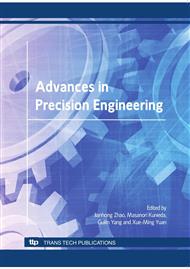p.21
p.26
p.31
p.36
p.41
p.46
p.51
p.55
p.61
The Effect of One Directional Ultrasonic Vibration Assistance in High Speed Meso-Scale Milling Process
Abstract:
One-directional ultrasonic vibration assisted milling system is designed and its performance is investigated in terms of machined surface quality under 135,000 rpm. The ultrasonic vibration generator excites the workpiece with a frequency around 40 kHz and amplitude of a few micro meters. The milling tool’s cutting speed is controlled by an air-bearing spindle system. Both feed-directional and cross-feed directional ultrasonic vibration assistance are considered in order to understand the mechanism of ultrasonic vibration assistance for surface roughness generation. A comparison is done on a milled surface which is generated with and without ultrasonic vibration assistance. The experimental results show that ultrasonic vibration assistance can improve the machined surface quality which depended on the cutting edge radius and the feed per tooth.
Info:
Periodical:
Pages:
41-45
Citation:
Online since:
September 2010
Authors:
Price:
Сopyright:
© 2010 Trans Tech Publications Ltd. All Rights Reserved
Share:
Citation:


